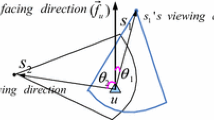Abstract
In order to maximize full-view coverage of moving targets in Camera Sensor Networks (CSNs), a novel method known as “group set cover” is presented in this research. Choosing the best camera angles and placements to accomplish full-view coverage of the moving targets is one of the main focuses of the research in CSNs. Discretize the target into multiple views of [0, 2\(\pi \)], use a set of views of targets to represent the sensing direction of the camera sensor, and use a group set of views of targets to represent the position of the camera sensor. The total number of targets in a dynamic time window that is visible in full view is calculated. A mixed integer linear programming formulation is employed, which is then approximated using a random rounding method. This approximation approach offers a global estimation of local optimality, particularly for non-submodular optimization problems. Two methods for maximizing overall full-view coverage within a dynamic time window are proposed TSC-FTC-DTW and FTC-TW-DTW. Finally, the proposed methods are verified through experiments.








Similar content being viewed by others
Data availability
This research conducted did not involve the creation or analysis of any datasets that could be shared.
References
Liu C, Du H (2021) t, K-Sweep coverage with mobile sensor nodes in wireless sensor networks[J]. IEEE Int Things J 8(18):13888–13899
Luo H, Du H, Kim D, Ye Q, Zhu R, Jia J (2014) Imperfection better than perfection: Beyond optimal lifetime barrier coverage in wireless sensor networks. 2014 10th International Conference on Mobile Ad-hoc and Sensor Networks. IEEE, 24-29
Du H, Zhang Z, Duan Z, Tian C, Du D-Z (2022) Formulate full view camera sensor coverage by using group set coverage. International Wireless Internet Conference. Cham: Springer Nature, Switzerland
Du H, Su J, Zhang Z, Duan Z, Tian C, Du D-Z (2024) Full View Maximum Coverage of Camera Sensors: Moving Object Monitoring[J]. ACM Transactions on Sensor Networks, 1-23
Wu W, Zhang Z, Lee W, et al. (2020) Optimal coverage in wireless sensor networks[J]. 2020. Springer. https://doi.org/10.1007/978-3-030-52824-9
Su J, Du H (2023) Algorithms for Full-View Coverage of Targets with Group Set Cover. International Computing and Combinatorics Conference. Cham: Springer Nature, Switzerland
Wu P-F, Xiao F, Sha C, Huang H-P, Wang R-C, Xiong N-X (2017) Node scheduling strategies for achieving full-view area coverage in camera sensor networks[J]. Sensors 17(6):1303
Sun Z, Zhao G, Xing X (2018) ENCP: A new energy-efficient nonlinear coverage control protocol in mobile sensor networks[J]. EURASIP J on Wirel Commun Netw 2018:1–15
Zhu X, Zhou M (2023) Multiobjective optimized deployment of edge-enabled wireless visual sensor networks for target coverage[J]. IEEE Int Things J 10(17):15425
Wang Y, Cao G (2011) On full-view coverage in camera sensor networks. In: 2011 Proceedings IEEE INFOCOM. IEEE, 1781-1789
Zhu X, Zhou M, Abusorrah A (2021) Optimizing node deployment in rechargeable camera sensor networks for full-view coverage[J]. IEEE Int Things J 9(13):11396–11407
Liu Z, Jiang G (2021) Sensor density for full-view problem in heterogeneous deployed camera sensor networks[J]. KSII Trans on Int Inform Syst (TIIS) 15(12):4492–4507
Gan X, Zhang Z, Fu L, Wu X, Wang X (2019) Unraveling impact of critical sensing range on mobile camera sensor networks[J]. IEEE Trans on Mob Comput 19(4):982–996
He S, Shin DH, Zhang J, Chen J, Sun Y (2015) Full-view area coverage in camera sensor networks: Dimension reduction and near-optimal solutions[J]. IEEE Trans on Vehicular Technol 65(9):7448–7461
Wu Y, Wang X (2012) Achieving full view coverage with randomly-deployed heterogeneous camera sensors. In: 2012 IEEE 32nd International Conference on Distributed Computing Systems. IEEE, 556-565
Shi K, Liu S, Li C, He S, Zhang Q, Chen J (2022) Toward optimal deployment for full-view point coverage in camera sensor networks[J]. IEEE Int Things J 9(21):22008–22021
Wang Y, Cao G (2013) Achieving full-view coverage in camera sensor networks[J]. ACM Trans on Sens Netw (ToSN) 10(1):1–31
Liu Z, Jiang G (2021) Sensor parameter estimation for full-view coverage of camera sensor networks based on bounded convex region deployment[J]. IEEE Access 9:97129–97137
Acknowledgements
We are deeply grateful to the editor and the anonymous reviewers for their insightful and constructive feedback. Their suggestions have been instrumental in enhancing the clarity and rigor of our manuscript.
Funding
This work is supported by the National Natural Science Foundation of China (No. 62172124), the Shenzhen Basic Research Program (Project No. JCYJ20190806 143011274), and the Shenzhen Science and Technology Program (Grant No. RCBS2021060910 3900003).
Author information
Authors and Affiliations
Corresponding authors
Ethics declarations
Conflict of interest
The authors declare that they have no Conflict of interest.
Additional information
Publisher's Note
Springer Nature remains neutral with regard to jurisdictional claims in published maps and institutional affiliations.
Rights and permissions
Springer Nature or its licensor (e.g. a society or other partner) holds exclusive rights to this article under a publishing agreement with the author(s) or other rightsholder(s); author self-archiving of the accepted manuscript version of this article is solely governed by the terms of such publishing agreement and applicable law.
About this article
Cite this article
Su, J., Li, Z., Du, H. et al. Dynamic time window based full-view coverage maximization in CSNs. J Comb Optim 48, 42 (2024). https://doi.org/10.1007/s10878-024-01227-6
Accepted:
Published:
DOI: https://doi.org/10.1007/s10878-024-01227-6




